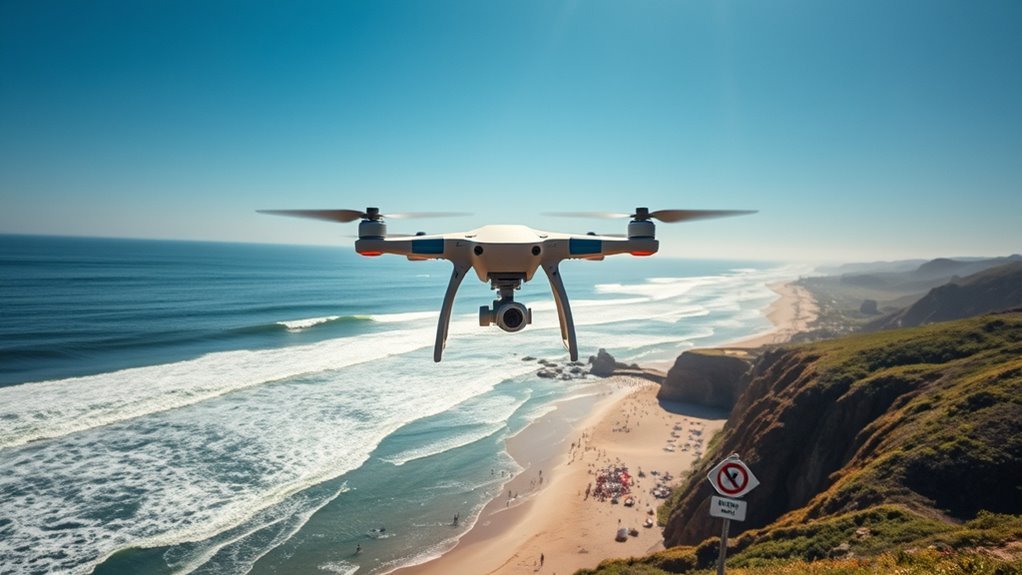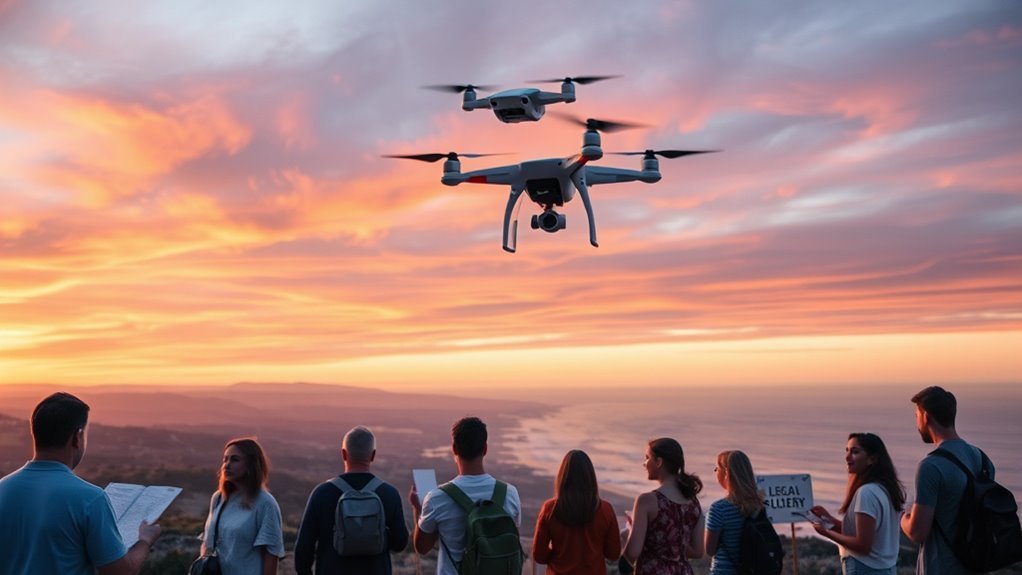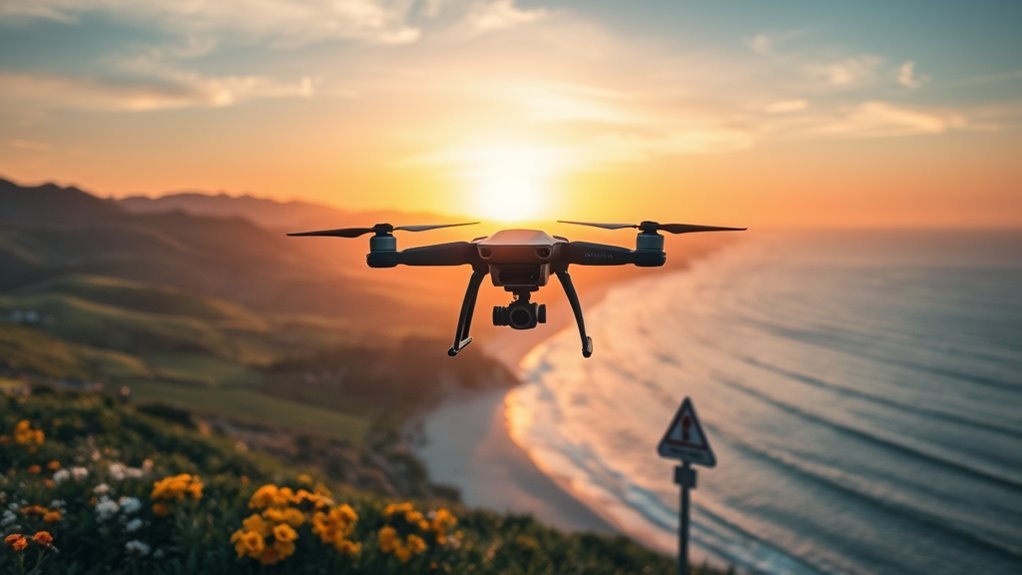To fly drones legally in California, you must register your drone with the FAA if it weighs over 0.55 pounds. Keep your drone within your sight and below 400 feet, avoiding crowds and private property without permission. Adhere to local ordinances, which may have additional restrictions on flight areas and times, especially in cities like Los Angeles or San Diego. Familiarizing yourself with no-fly zones is essential for compliance. Discover more about safe flying practices and regulations.
Understanding Federal Regulations for Drone Use

What do you need to know about federal regulations when flying drones in California? First and foremost, you must adhere to the drone registration requirements set by the FAA. If your drone weighs over 0.55 pounds, you’ll need to register it online, which is a straightforward process. Compliance with FAA guidelines is essential for ensuring safety and legality in your flying activities. You’re required to keep your drone within visual line of sight, avoid flying over people, and stay below 400 feet. Additionally, you should keep away from restricted airspace, such as near airports. By understanding and following these regulations, you can enjoy the freedom of flying your drone while staying within the legal framework established by the federal government.
California State Laws and Drone Restrictions

While understanding federal regulations is vital, it’s equally important to be aware of California state laws that govern drone use. In California, you’ll need to make sure your drone is properly registered with the FAA if it weighs over 0.55 pounds. Additionally, you must adhere to the state’s flight permissions, especially when flying in designated airspace or near sensitive areas like schools and hospitals. California law prohibits flying drones over private property without permission, so always seek consent from landowners. State regulations may impose additional altitude restrictions beyond federal guidelines, which is crucial to understand. Remember, respecting privacy and safety is essential to maintaining your freedom to fly. By staying informed on these state laws, you can enjoy your drone experience while avoiding legal troubles. Always check for updates to guarantee compliance. Understanding airspace ownership and drone laws will further aid in navigating the complexities of drone operation in California.
Local Ordinances Affecting Drone Flight

As you navigate the skies with your drone, it’s crucial to recognize that local ordinances can greatly impact where and how you can fly. Many cities have specific regulations that may include restrictions on flight altitudes, operational times, and even noise ordinances. Familiarizing yourself with these city regulations guarantees you can enjoy your flying experience without legal woes.
| City | Flight Restrictions | Noise Ordinances |
|---|---|---|
| Los Angeles | No flying over parks or schools | Must maintain low noise |
| San Francisco | Limitations near Golden Gate Park | Regulated hours only |
| San Diego | Restricted in residential areas | Quiet hours enforced |
| Sacramento | Height limits in urban areas | Continuous noise ban |
Stay informed to keep your flights enjoyable and compliant!
No-Fly Zones and Airspace Classifications
Understanding no-fly zones and airspace classifications is essential for safe and legal drone operation in California. No-fly zones are specific areas where drone flight is prohibited, often due to safety concerns, such as near airports, military bases, or emergency response zones. Familiarizing yourself with these zones is vital to avoid fines or legal issues.
Airspace classifications further dictate where you can fly. For example, Class B airspace surrounds busy airports and requires special permissions to operate. Meanwhile, Class G airspace is generally unrestricted but still has limitations. Always check the FAA’s guidelines and local regulations to guarantee you’re flying within the law. By understanding these classifications, you can enjoy your freedom while flying responsibly.
Safety Guidelines for Recreational and Commercial Pilots
To guarantee a safe flying experience, it’s essential for both recreational and commercial drone pilots in California to adhere to established safety guidelines. This includes routine drone maintenance to verify your equipment is in top shape and participating in pilot education programs to stay informed about regulations. Additionally, understanding the importance of flight stability can significantly enhance your drone’s performance in various conditions. Engaging in pre-flight checks ensures that your drone’s systems are functioning correctly, reducing the risk of malfunctions during flight.
| Safety Guidelines | Description |
|---|---|
| Pre-Flight Checks | Inspect your drone for any damage. |
| Maintain Line of Sight | Always keep your drone within visual range. |
| Respect Privacy | Avoid flying over private property without permission. |
| Fly Below 400 Feet | Stay under the altitude limit to avoid manned aircraft. |
| Avoid Crowds | Keep your drone away from populated areas. |
Tips for Responsible Drone Operation in California
While flying drones can be an exhilarating experience, it’s essential to operate them responsibly to guarantee safety and compliance with California regulations. Always maintain a line of sight with your drone and avoid flying near airports or in restricted airspace. When capturing stunning drone photography, respect the privacy of others and avoid filming in sensitive areas. Be mindful of wildlife protection laws; keep your drone at a safe distance from animals to prevent stress or disruption. Additionally, familiarize yourself with local laws regarding drone use in parks and natural reserves. By following these guidelines, you’ll not only enjoy your freedom to fly but also contribute to a safer environment for everyone, including wildlife.
Frequently Asked Questions
Can I Use My Drone for Personal Photography in Public Parks?
You can use your drone for personal photography in public parks, but you must follow drone photography regulations. Check for public park restrictions that may limit flight times or require permits before flying.
Are There Specific Insurance Requirements for Flying Drones in California?
Oh, sure, who needs insurance when you’re soaring through the skies? But seriously, you should consider liability coverage to protect against mishaps. It’s not just smart; it’s often essential for flying legally in California.
What Should I Do if I Encounter a Drone While Flying?
If you encounter a drone while flying, practice good drone etiquette. Maintain a safe distance, avoid sudden maneuvers, and signal your intentions clearly. Prioritize safety precautions to guarantee a smooth experience for both pilots.
How Do I Report a Drone Incident or Violation?
If you witness a drone incident, follow reporting procedures by documenting details like time, location, and involved parties. Contact local authorities or the FAA, ensuring you advocate for your freedom while promoting responsible drone operation.
Can I Fly a Drone at Night in California?
Yes, you can fly a drone at night in California, but you must follow night flying regulations. Confirm your drone meets visibility requirements, like having appropriate lighting to maintain safe operations and avoid hazards.

